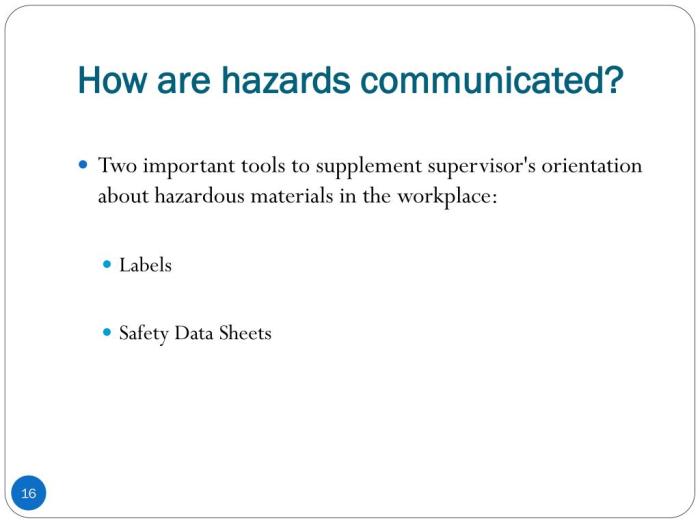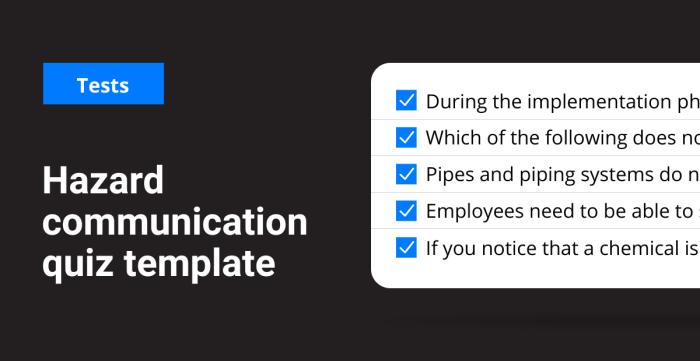Hazard communication quiz answers true or false – Welcome to our comprehensive hazard communication quiz! This interactive assessment will test your understanding of crucial concepts related to workplace safety. By answering true or false questions, you’ll gain valuable insights into hazard identification, risk assessment, safety precautions, and more.
Hazard communication is paramount in ensuring a safe and healthy work environment. This quiz will provide you with a solid foundation in this essential topic.
Hazard Communication

Hazard communication is a critical aspect of workplace safety, ensuring that employees are aware of the potential hazards associated with their work and how to protect themselves from them.
True/False Questions
- Hazard communication only involves providing employees with written information about hazards.
- Risk assessment is not required for all workplaces.
- Safety data sheets (SDSs) are only relevant for chemical hazards.
- Employees are not responsible for reporting hazards in the workplace.
- Hazard communication training is only necessary for new employees.
Hazard Identification
Hazard identification is the process of identifying potential hazards in the workplace. This can be done through various methods, such as inspections, risk assessments, and reviewing safety data sheets (SDSs).
Hazard identification is crucial because it allows employers to take steps to eliminate or control hazards, reducing the risk of accidents and injuries.
Safety Data Sheets (SDSs)
Safety data sheets (SDSs) are essential components of hazard communication. They provide detailed information about the hazards associated with a specific chemical substance or product.
SDSs include information such as hazard classification, protective measures, and emergency procedures. They are a valuable resource for employees and emergency responders.
Hazard Communication Training
Hazard communication training is required for all employees who may be exposed to hazardous substances or situations in the workplace.
Training can be provided through various methods, such as online, in-person, or on-the-job training. It should cover topics such as hazard identification, risk assessment, and safety precautions.
Hazard Communication Program
An effective hazard communication program includes elements such as hazard identification, SDSs, training, and employee responsibilities.
It is important to maintain and update the program regularly to ensure that it remains effective and up-to-date.
Employee Responsibilities
Employees play a vital role in maintaining a safe workplace through hazard communication.
They are responsible for reporting hazards, following safety procedures, and using personal protective equipment (PPE).
Best Practices, Hazard communication quiz answers true or false
Effective hazard communication involves following best practices, such as:
- Using clear and concise language.
- Providing training in a language that employees can understand.
- Keeping SDSs readily accessible.
- Encouraging employees to report hazards and ask questions.
- Conducting regular hazard assessments.
Clarifying Questions: Hazard Communication Quiz Answers True Or False
What is the primary purpose of a Safety Data Sheet (SDS)?
An SDS provides comprehensive information about the hazards associated with a chemical substance, including its physical and chemical properties, health effects, and safe handling procedures.
Who is responsible for maintaining and updating a hazard communication program?
The employer is ultimately responsible for developing, implementing, and maintaining an effective hazard communication program.
What are the key elements of an effective hazard communication program?
Effective hazard communication programs include hazard identification, Safety Data Sheets, employee training, labeling, and regular program review and updates.


